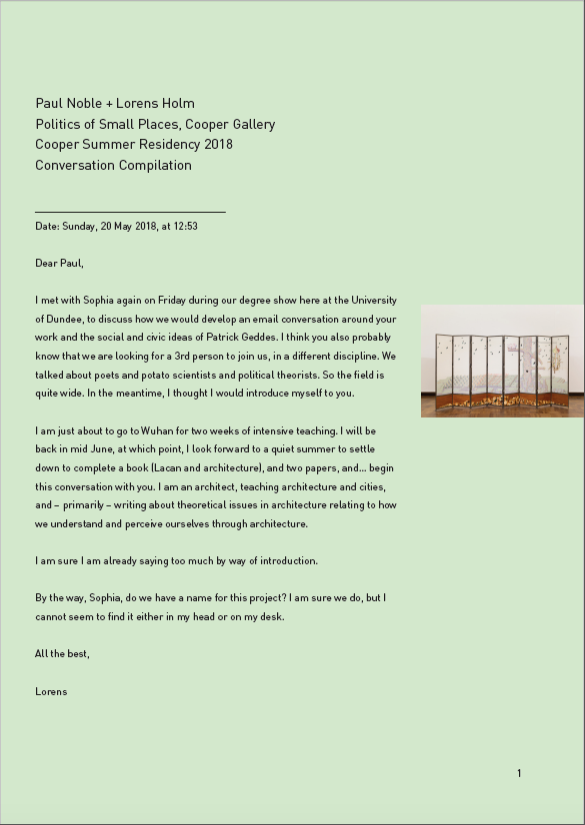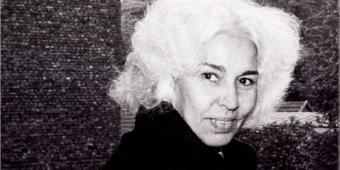Online Residency
Cooper Summer Residency 2018
Date: 2 July 2018 - 13 September 2018
Gallery: Cooper Gallery
Thinkers in Residence: Lorens Holm + Paul Noble
Cooper Summer Residency is an annual programme for artists, writers and thinkers to reflect upon and experiment with ideas and strategies that will extend their practice. It is a social and discursive situation for dialogues and debates to take place between residency artists, writers, thinkers and publics, providing an alternative way to encounter, reflect and critique the plurality of contemporary culture.
The 2018 edition of Cooper Summer Residency is an online residency and unique platform for critical and cross-disciplinary conversations. With Dundee fast becoming a destination on the global cultural map, Cooper Gallery subversively invites a counter dialogue to explicate the relationships between architecture, urban planning, sustainability, collective consciousness and contemporary art. Lorens Holm, Director of Geddes Institute for Urban Research at the University of Dundee, will engage in a four-week correspondence with preeminent contemporary artist Paul Noble preceding Noble’s upcoming exhibition Politics of Small Places alongside works from the Geddes Archive Collections at the University of Strathclyde, which will be exhibited at Cooper Gallery in September.
The Residency will culminate in an in-conversation event between Holm and Noble at the preview of the exhibition Politics of Small Places on Thursday 13 September at Cooper Gallery, where they will be joined by Dr. Louise Reid, researcher in Sustainable Development and Geography at the University of St Andrews.
The correspondence between Holm and Noble and Holm’s reflection on the pioneering Scottish urban planner Patrick Geddes’ thinking will be presented across Cooper Gallery’s website, social media channels and Group Critical Writing site.
*
Lorens Holm Reflection No. 1
Read Dr. Lorens Holm's introductory text on Patrick Geddes, contexualising the premise of the Thinkers Residency and dialogue with Paul Noble: Patrick Geddes and Paul Noble

Lorens Holm Reflection No. 2
We can use Geddes' thought to... Read on: Lorens Holm reflection 2
-01-01-473x181_929720950.png)
Paul Noble + Lorens Holm Conversation Compilation

Download the entire Paul Noble and Lorens Holm conversation.
*
Paul Noble: Reading List + Playlist
Throughout this online Residency we will be publishing suggested reading and listening material selected by Paul Noble.
-
God Dies by the Nile (1985) by Egyptian feminist writer Nawaal El-Sadaawi, founder of the Arab Women's Solidarity Association & co-founder of the Arab Association for Human Rights. Read an interview with her from The Guardian in 2015 here.


-
The Earthquake in Chile (1807) a brutal short story by the German writer Heinrich von Kleist in which citizens of a city grapple with theodicy and morality in the midst of natural disaster.
-
Second Hand Time (2013) by 2015 Noble Prize for Literature winner Svetlana Alexievic. Here she weaves together true stories from the former-Soviet Union, including Gulag survivors and ex-Communist Party officials. Read more about Alexievic’s work on her website.
-
Jean Joseph Goux, Oedipus, Philosopher (1993). Here an argument is made for a more analytical reading of the Oedipus mythology, leading to a reevaluation of Freudian theory.
-
Michel Serres, Statues (1987). A philosophical and poetic meditation on the history and legacy of statues from ancient times to the present, touching on the monumental and civic themes explored in Noble's own work.
-
Samuel Beckett, Watt (1953). Written on the run from the Gestapo, is described by the New Yorker as "The product of a brilliant mind reckoning with the brutal caprices of fascism".
-
Samuel Beckett, Mercier & Camier (1970). The story of two men in a complex relationship with each other and a fictionalised Dublin. Keith Ridgway reflects on the novel for the Guardian.
-
Samuel Beckett, Malone Dies (1951).
*
Biographies
Dr. Lorens Holm is Reader in Architecture and Director of the Geddes Institute for Urban Research at the University of Dundee. At Dundee he runs the Rooms+Cities design research unit, which uses architectural theory to open up a space for designing new forms of city and social life. He has taught at the Architectural Association, the Bartlett, the Mackintosh, and Washington University in St. Louis. He is a registered architect in the UK and the State of Massachusetts. His teaching/research focuses on the thought threads that link architecture to philosophy, history, psychoanalysis, and machines. Publications include Brunelleschi Lacan Le Corbusier: architecture space and the construction of subjectivity (Routledge 2010) and, with John Hendrix, Architecture and the Unconscious (Routledge 2016). His papers have appeared in The Journal of Architecture, Perspecta, Critical Quarterly, Architecture Theory Review, and Assemblage. He is currently organizing an international interdisciplinary conference on cities and the collective social formations that inhabit them.
In 2015 the Geddes Institute for Urban Research curated The City is a Thinking Machine, an exhibition and associated events that sought to evaluate the relevance of Geddes’ thought for today by situating it alongside the work of contemporary practice.
Paul Noble is a contemporary artist forging a unique and maverick path in the ebullient British art scene. He received widespread international recognition for his vast and monumental drawing project, Nobson Newtown,which he began in 1996. Drawing image after image, story after story—at once architect and town planner, archaeologist and cartographer, social historian and activist, creator and destroyer—Noble has invented and described a melancholy urban vision somewhere between Le Doux’s revolutionary utopias, Sim City, and the post-holocaust wastelands pictured in the daily media. A meticulous and dedicated draftsman, Noble creates dizzyingly elaborate encrypted schemes, drawing from inspirations as diverse as ancient Chinese scrolls and Japanese sculptures, Fabergé eggs and brick walls, eighteenth-century pornography and animal rights, Hieronymous Bosch and Oyvind Fahlstrom. The sheer level of detail in his drawings defies the capacity of the eye to see and the mind to fully grasp them.
Recent solo museum exhibitions include Paul Noble: New Works, Gagosian San Francisco, USA (2017); Paul Noble: Nobson, Museum Boijmans Van Beuningen Rotterdam, Netherlands (2014); Paul Noble: The Gates, Gagosian Gallery Athens, Greece (2013); Paul Noble Marble Hall, Laing Art Gallery Newcastle, UK (2011) and TENT, Cooper Gallery Dundee, UK (2011). Noble currently lives and works in London. He was nominated for the Turner Prize in 2012.
Dr. Louise Reid is a social scientist interested in what and why people do what they do, and the impact of these activities on the environment. As a human geographer, she explores how these activities are organised across time and space with a focus on the everyday domestic setting. Louise is currently based at the University of St Andrews in the School of Geography and Sustainable Development where she contributes to the successful MA/BSc Sustainable Development, MA/BSc Geography, and MSc/MRes Sustainable Development programmes. Louise is also Director of the University’s Centre for Housing Research. Louise moved to St Andrews from the University of Aberdeen in 2010, initially taking up a research fellowship with CHR, before moving into a Lectureship in 2011. Louise completed her PhD in 2010 and also has an MSc in Sustainable Rural Development (2004) and an MA (Hons) in Environmental Geography (2003).
*
Slide Show Image credits:
Paul Noble, Egg Carton technique Actual, Pencil on paper, 2004. Courtesy the Artist.
Patrick Geddes, ‘Illustration of ‘Valley Section’ symbolising rustic types under leadership of the Hunter Warrior for War and under co-ordination of the Peasant-Shepherd for Civilisation’, Drawing on paper, date unknown, courtesy the University of Strathclyde Archives and Special Collections.
Patrick Geddes, 'The Arts in Relation to Applied Sociology’, Drawing on paper, date unknown, courtesy the University of Strathclyde Archives and Special Collections.

_1884439900.jpg)

